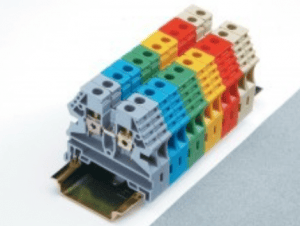In complex electrical panels, clarity and safety are everything. That’s where colored terminal blocks come in. Rather than using identical-looking blocks for every connection, engineers can specify color-coded terminal blocks to instantly differentiate wiring functions—improving organization, reducing errors, and enhancing safety during installation and maintenance.
🔧 What Do the Colors Represent?
While color conventions can vary by region or industry, here are some common standards used in the U.S. and internationally:
Color Typical Use
Gray/Beige AC hot
Blue AC Neutral
Red DC positive
Black DC negative or AC hot
Green Protective Earth (PE) or ground
Green/Yellow Safety ground (protective conductor)
Orange Interlock or control circuit
White AC Neutral
Yellow Alternate voltage or unusual condition circuits
🧠 Why Engineers Should Specify Colored Terminal Blocks
✅ Improved Clarity & Faster Wiring Techs can wire panels faster and with fewer mistakes when each function is color-coded.
✅ Enhanced Safety Color-coding helps prevent accidental cross-connections, especially between AC and DC circuits or control and power.
✅ Easier Troubleshooting & Maintenance Service teams can quickly identify circuits in the field without needing to trace each wire individually.
✅ Standardization Across Projects Specifying colors ensures consistency across builds and helps meet industry or company wiring standards.
✅ Code Compliance In many regions, identifying grounding (green/yellow) or neutral conductors by color is required for safety and code adherence.
American Electrical, Inc. (AEI) sells a complete line of Internationally approved, highly competitive DIN Rail mounted Terminal blocks, made by Klemsan, in all the colors you may require!! Call us at 804.379.2899 or visit our website here:
https://catalog.americanelectrical.com/category/din-rail-mounted-terminal-blocks1
Thanks Followers !!
🧰 Final Thought:
Specifying colored terminal blocks isn’t just about looks—it’s about safety, efficiency, and professionalism. In a world of ever-more-complex electrical systems, visual communication is key, and color-coding is a simple way to make your panel smarter.










